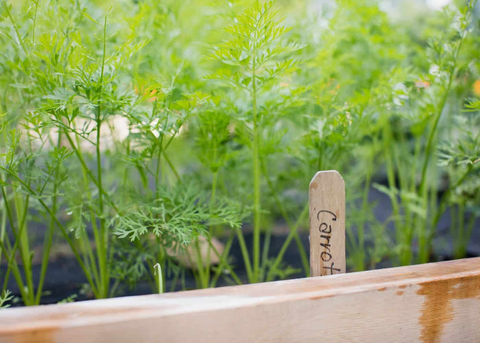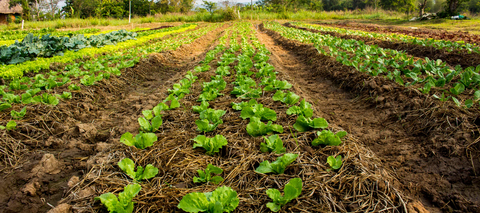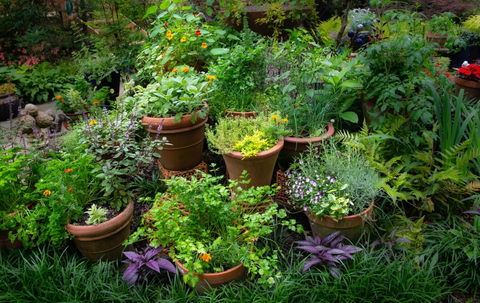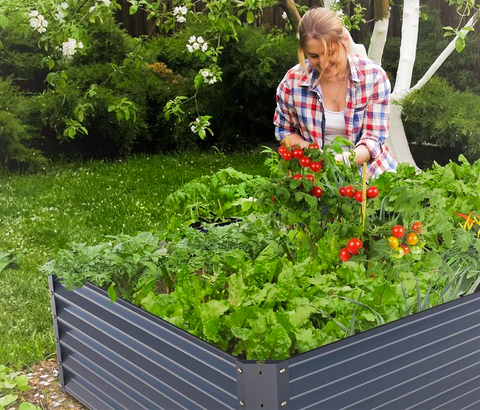In today's environmentally conscious world, the practice of reducing waste and repurposing resources has never been more vital. One of the most rewarding and sustainable ways to achieve this is by using kitchen scraps to enhance your garden. Not only does this practice reduce the amount of waste sent to landfills, but it also nourishes your garden with natural nutrients and fosters a healthier ecosystem. In this comprehensive guide, we'll explore the myriad ways you can harness the potential of kitchen scraps to transform your garden into a flourishing haven of sustainability.The following content also has some reference value for raised garden beds.
The Value of Kitchen Scraps
Before we delve into the practical applications of kitchen scraps in the garden, let's take a moment to appreciate their inherent value:
- Waste Reduction: By reusing kitchen scraps in your garden, you significantly reduce the amount of organic waste that ends up in landfills, thereby decreasing your environmental footprint.
- Nutrient-Rich Resources: Kitchen scraps, such as fruit and vegetable peels, coffee grounds, and eggshells, are rich in organic matter and essential nutrients like nitrogen, phosphorus, and potassium. These elements are essential for plant growth and soil health.
- Cost-Efficiency: Utilizing kitchen scraps as natural fertilizers and soil conditioners eliminates the need for store-bought alternatives, saving you money while promoting eco-friendly practices.
- Ecosystem Enhancement: Incorporating kitchen scraps into your garden attracts beneficial insects and microorganisms, contributing to a balanced and biodiverse ecosystem. This, in turn, helps control pests and promote plant growth.
- Educational Opportunity: Engaging in the practice of using kitchen scraps in the garden can be a valuable educational experience for both adults and children. It teaches the importance of resource conservation and sustainability.
Now that we've established the value of kitchen scraps, let's explore how to effectively utilize them to elevate your gardening game.

Composting: The Heart of Sustainable Gardening
Composting is a foundational practice in sustainable gardening. It involves the decomposition of organic materials, including kitchen scraps, to create nutrient-rich compost—a natural soil conditioner and fertilizer. Here's how to get started:
Ingredients: Collect kitchen scraps such as fruit and vegetable peels, coffee grounds, eggshells, and non-meat food scraps. Combine these with yard waste like leaves, grass clippings, and small twigs.
Layering: Begin your compost pile or bin by layering brown materials (carbon-rich, like dried leaves) and green materials (nitrogen-rich, like kitchen scraps). Continue adding layers as you generate waste.
Aeration: Regularly turn or aerate your compost pile to introduce oxygen, which helps break down the materials faster.
Time: Composting can take several months to a year, depending on conditions. Once the compost resembles dark, crumbly soil and has a pleasant earthy smell, it's ready to use as a soil amendment.
Application: Mix your finished compost into garden beds or use it as mulch. It improves soil fertility, structure, and moisture retention while introducing beneficial microorganisms.
Coffee Grounds: A Garden's Caffeine Boost
Used coffee grounds are a readily available kitchen scrap that offers several benefits in the garden:
Soil Amendment: Coffee grounds add organic matter to your soil, improving drainage and aeration. They also release nitrogen as they break down, enriching the soil.
pH Regulation: Coffee grounds are slightly acidic, making them an ideal addition to alkaline soils. They can help balance the pH levels for plants that prefer a more acidic environment.
Mulch: Apply a layer of coffee grounds around plants to help retain moisture, suppress weeds, and deter pests like snails and slugs.
Composting: Incorporate coffee grounds into your compost pile to boost nitrogen levels and speed up decomposition.
Eggshells: Nourishing Your Garden's Calcium Needs
Eggshells are rich in calcium, a crucial nutrient for plant health. Here's how to make the most of them:
Crushed Eggshells: After using eggs, rinse the shells and let them air dry. Crush them into small pieces and sprinkle them around your garden. Calcium is essential for strong cell walls in plants, which helps prevent issues like blossom end rot in tomatoes.
Seed Starters: Place crushed eggshells at the bottom of seedling containers or in garden furrows when planting seeds. This provides a slow-release source of calcium as the seedlings grow.
Composting: Eggshells can also be added to your compost pile to boost calcium levels in the finished compost.

Banana Peels: A Potassium Punch
Banana peels are high in potassium, a nutrient vital for flower and fruit development. Here's how to use them effectively:
Composting: Add banana peels to your compost pile to infuse it with potassium. As the peels break down, they release this essential nutrient into the compost.
Direct Application: Lay banana peels in the planting hole when transplanting or in the bottom of pots before potting plants. As they decompose, they release potassium to nearby roots.
Citrus Peels: A Zesty Soil Enhancer
Citrus peels from oranges, lemons, and other fruits can be put to good use in your garden.
Composting: Citrus peels can be added to your compost pile to contribute organic matter and introduce a pleasant scent.
Repelling Pests: The strong scent of citrus peels can deter pests like ants and aphids. Place dried citrus peels around vulnerable plants or bury them slightly in the soil.
Natural Cleaners: Create a homemade citrus cleaner by soaking citrus peels in vinegar for a few weeks. Dilute the solution with water and use it to clean garden tools, pots, and surfaces.
Vegetable Scraps: Fueling the Compost Pile
Vegetable scraps like carrot tops, lettuce leaves, and onion skins are excellent additions to your compost pile. These scraps break down into valuable nutrients that enrich your soil and promote plant growth.
Composting: Collect all vegetable scraps in a kitchen compost bin or a designated compost pile. Be sure to avoid adding diseased or moldy plant material to prevent the spread of diseases.
Garden Benefits: When you use the resulting compost in your garden, you're not just recycling kitchen waste; you're creating nutrient-rich soil that fosters healthier, more productive plants.

Herb Trimmings: Green Goodness
When you prune your herbs or trim them for culinary use, don't discard those clippings.
Propagation: Many herbs can be propagated from stem cuttings. Place these cuttings in water, and they'll often develop roots. Once rooted, you can transplant them into your garden or keep them in pots.
Composting: Herb trimmings can be added to your compost pile to contribute organic matter and nutrients.
Natural Pesticides: Some herb clippings can serve as natural pest repellents. For example, mint clippings can deter ants and aphids.
Stale Bread: Feeding the Birds (and Soil)
If you have stale or moldy bread, don't toss it in the trash. Repurpose it for the benefit of your garden.
Bird Food: Stale bread can be crumbled and scattered in your garden to attract birds. Birds help control insect populations, making them valuable garden allies.
Composting: If the bread is beyond use as bird food, it can still be added to your compost pile as a source of organic matter.
Nut Shells: Natural Mulch
Don't overlook the potential of nut shells, like walnut shells, as useful garden materials.
Mulch: Crushed nut shells can serve as mulch around plants. They help retain moisture, suppress weeds, and add a decorative touch to your garden.
Soil Conditioner: Over time, crushed nut shells break down, adding organic matter to the soil and enhancing its structure.
Corn Cobs: Slow-Release Fertilizer
After enjoying corn on the cob, don't discard the cobs. They can be beneficial in your garden:
Composting: Corn cobs can be added to your compost pile, where they gradually decompose, releasing nutrients and improving soil structure.
Homemade Fertilizer: Alternatively, you can make a homemade corn cob fertilizer by grinding the cobs into a coarse powder. Sprinkle this powder around your garden, and as it breaks down, it will release nutrients to your plants over time.
Onion and Garlic Skins: Natural Pest Control
The thin papery skins of onions and garlic, often seen as kitchen waste, can serve a valuable purpose in your garden.
Repelling Pests: These skins can deter pests like aphids and spider mites. Place them near affected plants or in problem areas of your garden.
Composting: Onion and garlic skins can also be added to your compost pile, where they'll break down and contribute nutrients to the soil.
Avocado Pits: Garden Ornaments
Avocado pits, while not a direct source of nutrients, can still find a place in your garden:
Decorative Elements: Polished avocado pits can be used as decorative ornaments or accents in your garden. They add a unique and natural touch to your outdoor space.
Potting Containers: Avocado pits can also be used as small plant pots for starting seeds or growing succulents.
Rotten Fruit: Nature's Fertilizer
When fruits become overripe or rotten, don't discard them. They can be transformed into garden gold.
Composting: Rotten fruit can be added to your compost pile, where it will break down and enrich the compost with valuable nutrients.
Natural Fertilizer: Blend rotten fruit with water to create a nutrient-rich fruit slurry. Dilute this mixture with additional water and use it to water your plants.
Cheese Grater: DIY Seed Spreader
Repurpose your old cheese grater into a handy garden tool.
Seed Spreader: Grated seeds can be used as a DIY seed spreader. Simply place seeds in the grater and shake it over the desired planting area.
Fertilizer Mixer: Use the grater to finely shred dry leaves or kitchen scraps for faster decomposition in your compost pile.

Sturdy Containers: Seedling Starters
Many kitchen containers can be repurposed into seedling starters.
Egg Cartons: Empty egg cartons make excellent seedling starters. Fill each egg cup with potting mix and plant your seeds. Once the seedlings are ready for transplanting, cut apart the individual cups and plant them directly in the garden.
Yogurt Cups: Rinse and save yogurt cups for starting seedlings. Poke holes in the bottom for drainage and fill with potting soil.
Citrus Halves: After juicing citrus fruits, save the halves and fill them with soil for seedlings. The citrus peel can deter pests while providing a biodegradable container for your plants.
Potato Bags: Vertical Gardening
If you have old potato bags or burlap sacks, don't discard them. They can serve as versatile containers for vertical gardening:
Vertical Planters: Fill potato bags or burlap sacks with potting soil and plant your favorite herbs, vegetables, or flowers. Hang them in a sunny spot, and you'll have a space-saving garden that's both functional and visually appealing.
Plastic Bottles: Drip Irrigation
Repurpose plastic bottles into a simple and effective drip irrigation system.
Watering Spikes: Drill small holes in the caps of plastic bottles. Bury the bottles upside down in the soil near your plants. Fill them with water, and they will slowly release moisture directly to the root zone.
Seedling Protectors: Cut the bottom off a plastic bottle to create a protective cloche for young seedlings. This can help shield them from pests and adverse weather conditions.
Ice Cube Trays: Seedling Starters
Old ice cube trays can be transformed into convenient seedling starters:
Seed Compartments: Fill each compartment with potting soil and plant your seeds. Once the seedlings are ready for transplanting, simply pop them out of the tray for easy handling.
Water Reservoir: Ice cube trays can also be used to create a self-watering seedling system. Fill some of the compartments with water and place the seedling trays on top. The soil will absorb water through capillary action.
Milk Jugs: Mini Greenhouses
Empty milk jugs can be repurposed into miniature greenhouses for protecting seedlings:
Seedling Protection: Cut off the bottom of a milk jug and use the top half as a protective cloche for your young seedlings. This helps create a warm and sheltered environment for delicate plants.
Winter Plant Protection: In colder climates, milk jugs can be placed over plants to provide insulation and protect them from frost.
CD Cases: Seedling Greenhouses
Empty CD cases can be turned into miniature greenhouses for starting seeds:
Seed Protection: Place your seedlings inside the CD case, which acts as a transparent, protective cover. This helps create a warm and humid environment ideal for germination.
Conclusion
By repurposing kitchen scraps and everyday household items, you can significantly enhance the sustainability and productivity of your garden. This eco-friendly approach not only reduces waste but also nurtures a thriving ecosystem that benefits both your plants and the environment.
So, the next time you're tempted to discard kitchen scraps or old household items, consider their potential to contribute to the well-being of your garden. With a dash of creativity and a commitment to sustainability, you can transform these humble materials into valuable resources that make your garden flourish. Happy gardening, and may your garden thrive with the magic of recycling and repurposing!









